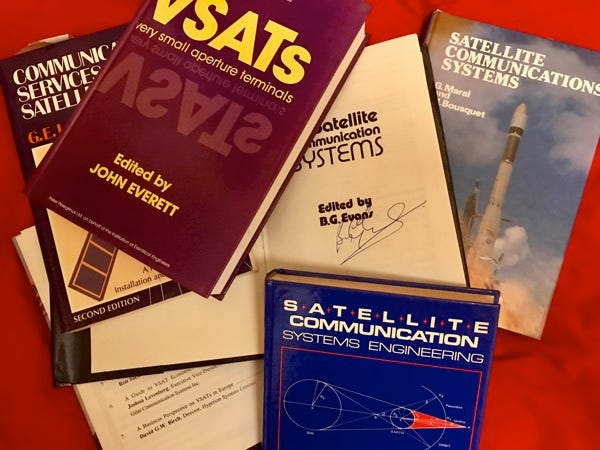Back to the future of Bitcoin
I was very excited to discover via the interweb tubes that Bitcoin is now going into geostationary orbit. In the near future, Bitcoins will be dropping as a gentle rain from heaven. Well, sort of.
Blockstream Satellite is the world’s first service that broadcasts real-time Bitcoin transactions and blocks from a group of satellites in space.
You cannot imagine the nostalgia this story generated for me because, astonishing as it may now seem, the first ‘fintech’ project that I ever worked on involved using satellites to transit financial data and the first book chapter that I ever wrote was about the use of satellite data for business.
Settle down youngsters, and I’ll tell you the tale…
Cast your mind back to 1982. Those interweb tubes are a distant dream. Getting data from place to place is a major effort. In a far away place (Indonesia) a group of talented 10x prima donna programmers are writing software to run on the world’s first regional satellite data system, the Palapa-B1 service (a Hughes HS376, for the technical, with 24 C-band transponders). In the great city of Bandung, one of these dashing young software engineers — me — was initially tasked with writing the (and here’s one for the teenagers) X.28 code and then the X.25 code to allow (amongst other things) bank terminals and other devices to connect via this new satellite network to allow communications between bank branches on far flung islands throughout the Indonesian archipelago and bank offices in Jakarta and elsewhere. You couldn’t buy communications software for the processors we were using. You had to write it from scratch. If you tell the young people of today that, they won’t believe you.

We were working at a telecoms supplier’s site in Bandung. I know it doesn’t look much from the outside.
A Japanese team were building the baseband modems and implementing the Aloha link protocol that had originally been invented for Alohanet. This gave me the assembly language primitives to work with to implement the CCITT protocols on top. X.28, as if you need any reminding, was the protocol for character input/output (used to connect terminals across a network to mainframes) and X.25 was the packet-switching protocol for interconnecting computers. I still think of terminals at DTEs (Data Terminating Equipment) and I still think of network connections as DCEs (Data Circuit Terminating Equipment). All of these quaint terms vanished from the pages of history about a week after TCP/IP was invented.

As you can see, inside we had access to many modern facilities.
Implementing X.28 meant that staff could log on to bank mainframes using terminals in the branches. Implementing X.25 meant that remote minicomputers could interconnect. Getting the code to work, and getting it to work quickly enough, and getting it to work in the limited memory available was a fantastic education. I loved my time as C ninja, interfacing with what was then leading-edge communications hardware to deliver data services to real users.

Here I am making a few small adjustments to the communications processors boards.
It was here I learned all my UNIX tricks and C programming stunts. Those were the days when if you didn’t like the way that the team wrote code you could quickly knock up a parser to force them into line (which one of my colleagues did, using YACC), when you had to pretend to the system administrator that you didn’t have root access (which we all did) and when the disk packs held 5Mb so you had to be very careful with the space available *wipes away a tear*.

As you can see, the team really appreciated my mad programming skills and their contribution to the great success of the project.
In the later 1980s and very early 1990s, I enjoyed working on a wide variety of projects around satellite data communications. I worked on technical architectures, system designs and even on regulation in a team with the now-infamous Vicky Pryce (who was then chief economist at KPMG, and who I remember as a very impressive and really clever, but also really nice person). The very first conference paper that I ever wrote was on the use of satellite data broadcasting to deliver stock exchange data to market participants and I spent happy days at Telekurs, Dow Jones Telerate, the London Stock Exchange and other places working on link budgets, low-noise blocks and forward error correcting codes (this is where I learned about convolutional coding and Viterbi decoders. One of the most interesting areas I worked in was the use of Vertical Blanking Interval (VBI) data services embedded in analogue television transmissions and the potential (abandoned) use of data space in digital television transmissions for value-added (largely financial) services.

A few years later, I worked on a similar system using Very Small Aperture (VSAT) terminals in K-band (too much information, ed.) for a US telecommunications provider, on one of Consult Hyperion’s first US projects. In those still pre-internet days, if you wanted to get data from a branch office back to HQ reasonably quickly you had to pay for a leased data line from the phone company, which was very expensive. Putting a satellite terminal on your roof was a cheaper alternative and as the frequencies went up from C- to Ku-based, so the dish sizes and costs came down. The cost of installing and maintaining a six foot dish compared very favourably with the costs of alternatives, until the internet and mobile phones came along and spoiled all the fun.
Ah, the good old days.




